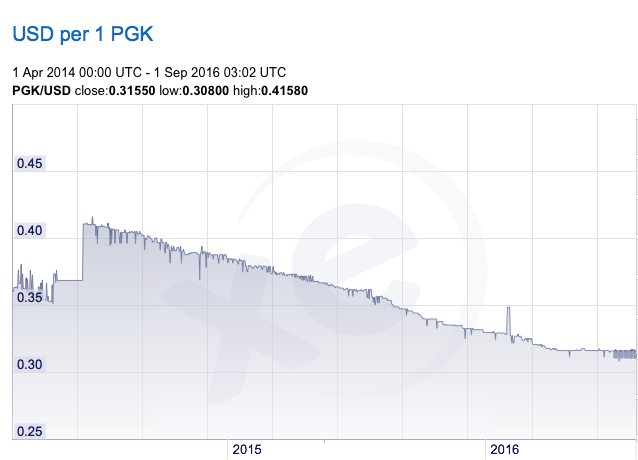Papua New Guinea’s top two bankers – Loi Bakani, Governor of the Bank of Papua New Guinea and Robin Fleming, Chief Executive of Bank South Pacific – have set the record straight on the country’s foreign exchange challenges. Contrary to some suggestions, the shortage of foreign exchange is due to imbalances between supply and demand, rather than controls, they say. Also, encouragingly, there are some indications that PNG’s currency market may be starting to re-balance.
Central bank Governor Loi M Bakani this week told ‘Business Advantage Boardroom‘—a new regular feature on EMTV’s ‘Business PNG’ program—that the central bank had introduced a trading margin for the kina in June 2014 as a ‘correction to the price setting mechanism’ only.

‘It is not a control to stop the downward movement in the kina,’ explained Bakani. ‘The kina has been depreciating since 2012. From 2012 to 2016, it has depreciated against the US dollar by 36 per cent. It is a huge depreciation for the currency.
‘There are no controls around; there are no controls on what is permitted to go out of the country.’
‘The issue that we have in front of us is the lack of foreign exchange coming in. That is due to the low commodity prices that we have, low investment into Papua New Guinea and a lack of increase in exports to bring back the foreign exchange.’
No controls

Fleming agrees that the currency markets operate freely. ‘There are no controls around; there are no controls on what is permitted to go out of the country,’ he says.
‘The normal foreign exchange controls that existed in the past continue to exist at the moment.
‘All they [the central bank] did with the (trading) band was say to the banks—which had perhaps been unduly usurious in some of their profit margins—that you had to be a lot more reasonable about the profits that you are going to consume to the expense of the importer.’
Fleming agrees that PNG’s foreign exchange problems are related to the structure and flow of exports and imports.
‘The Governor is correct. It is very much a flow-based currency. It is unusual that you have a small number of exporters who deliver all of the dollars available for distribution, intermediated by the commercial banks for a very large number of importers.’
Re-balancing
Having argued that the foreign exchange market is free, Fleming also says he believes it is now starting to self-correct. He observes some hopeful signs of a rebalancing occurring. Over the past 12 months, he says, import orders have not increased and over the last three-to-four months they have started to reduce.
‘Obviously some of the large importers, who have significant demands, are still facing some issues in being able to regularize that.’
‘With many of the smaller to medium importers we are finding now that within two to three weeks they are able to get their reasonable orders placed and satisfied.
‘Capital payments are a little bit different. Obviously some of the large importers, who have significant demands, are still facing some issues in being able to regularize that.’
Fleming points to an improvement in commodity prices and commodity outputs in the agricultural sector. He adds that import cover ‘as a headline level hasn’t necessarily changed that much’. Imports are covered, he says, for about nine to 10 months, the level of 12 to 18 months ago.
Context
Fleming says a positive influence has been the re-opening of the Ok Tedi mine. He notes that Ok Tedi was out of the market ‘for the best part of nine months’ due to the drought. It equated with lost revenue of US$300–US$350 million ‘which was the equivalent almost of what the backlog of orders is.’
‘Fleming expects the foreign exchange situation to remain ‘difficult’ for the next 12 months, but he believes import demand will reduce. ‘It will start to normalize.’
‘We can’t re-cast what happened from an El Nino perspective, but equally you have to put these things into context.’
Fleming expects the foreign exchange situation to remain ‘difficult’ for the next 12 months, but he believes import demand will reduce. ‘It will start to normalise.’
Dutch disease
According to Fleming, in 2007–2008 the expectation was that PNG would suffer from so-called ‘Dutch disease’ (a skewing of the economy because of large investment in resources projects). He says it was expected that there would be a surplus of dollars associated with the PNG LNG gas project and the associated revenues.

Instead, the opposite occurred. ‘As it has transpired, around 2012/2013 we started to see gas prices—or oil prices, which are correlated with gas—start to fall significantly, considerably below what had been projected by all the experts associated with the modeling for PNG LNG.’
‘Imports have continued to remain apace at quite a significant level, without businesses necessarily contemplating that there was going to be a tailing off of demand in the country.’
Fleming says, by 2013/14, most of the foreign exchange inflows that had been associated with the construction phase had stopped, as was anticipated. He says the foreign exchange flows associated with the production phase have ‘actually not been as high’ as expected.
‘(Meanwhile) imports have continued to remain apace at quite a significant level, without businesses necessarily contemplating that there was going to be a tailing off of demand in the country.
‘What we have had is a significant build up in the import orders from various business which haven’t perhaps necessarily given due regard for some slowdown in economic activity.’
Predictions
Bakani is reluctant to predict where the kina is headed, saying that it is not the job of central bank to predict movement in currencies.
The Treasurer Patrick Pruaitch, however, has forecast in the Supplementary Budget a drop in the kina this year of 9.1 per cent against the US dollar and 12.6 per cent against the Australian dollar.
‘When the Bank of PNG feels comfortable that the banks are behaving the right way then the margin will be removed.’
Bakani says forecasting is a very risky business. ‘It can cause a lack of confidence in the economy and the management of the economy if I start to say the kina will continue to depreciate.’
Bakani says the trading margin, which is set at 75 basis points above and below the mid-point set by the market, will remain. He says when the Bank of PNG feels ‘comfortable that the banks are behaving the right way’ then the margin will be removed.
Source: Business Advantage PNG








